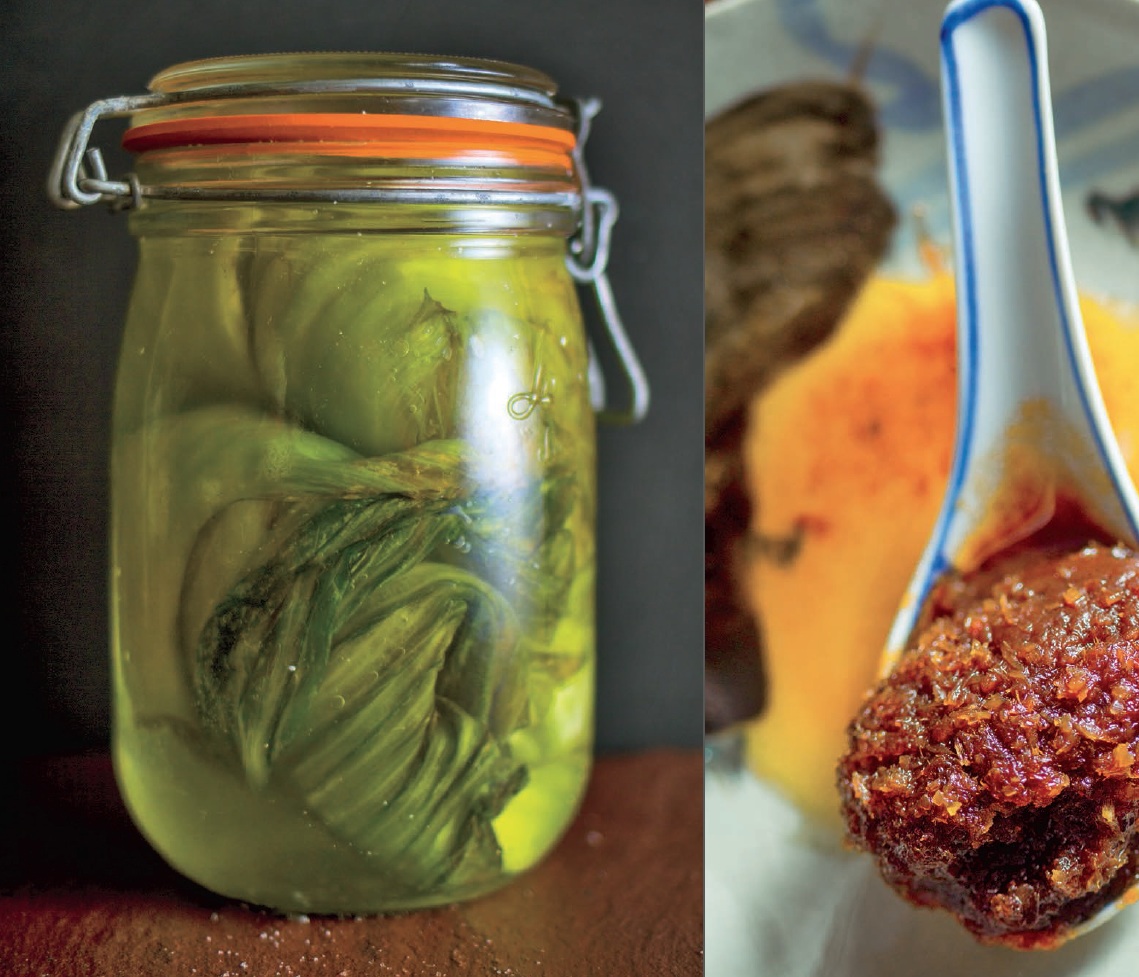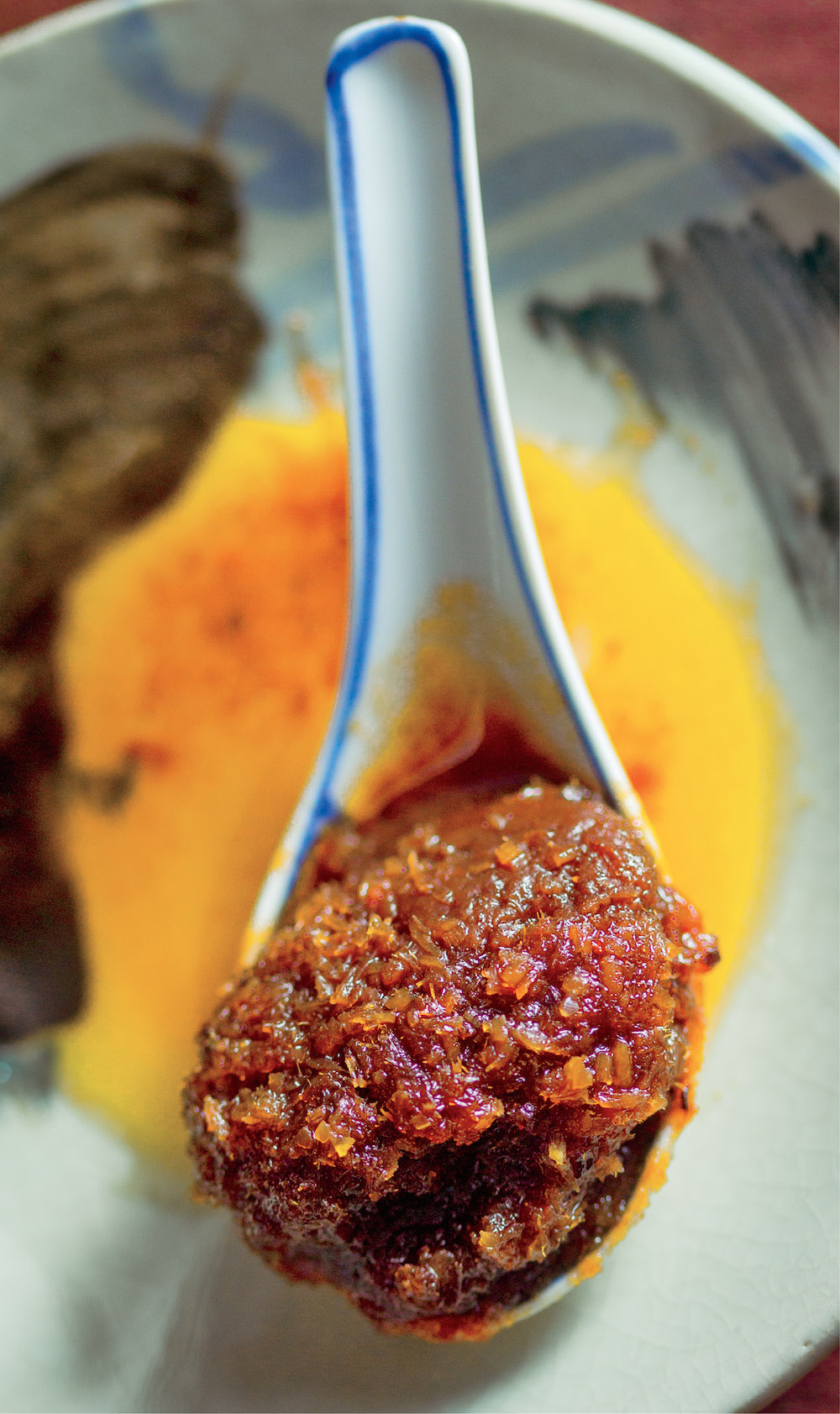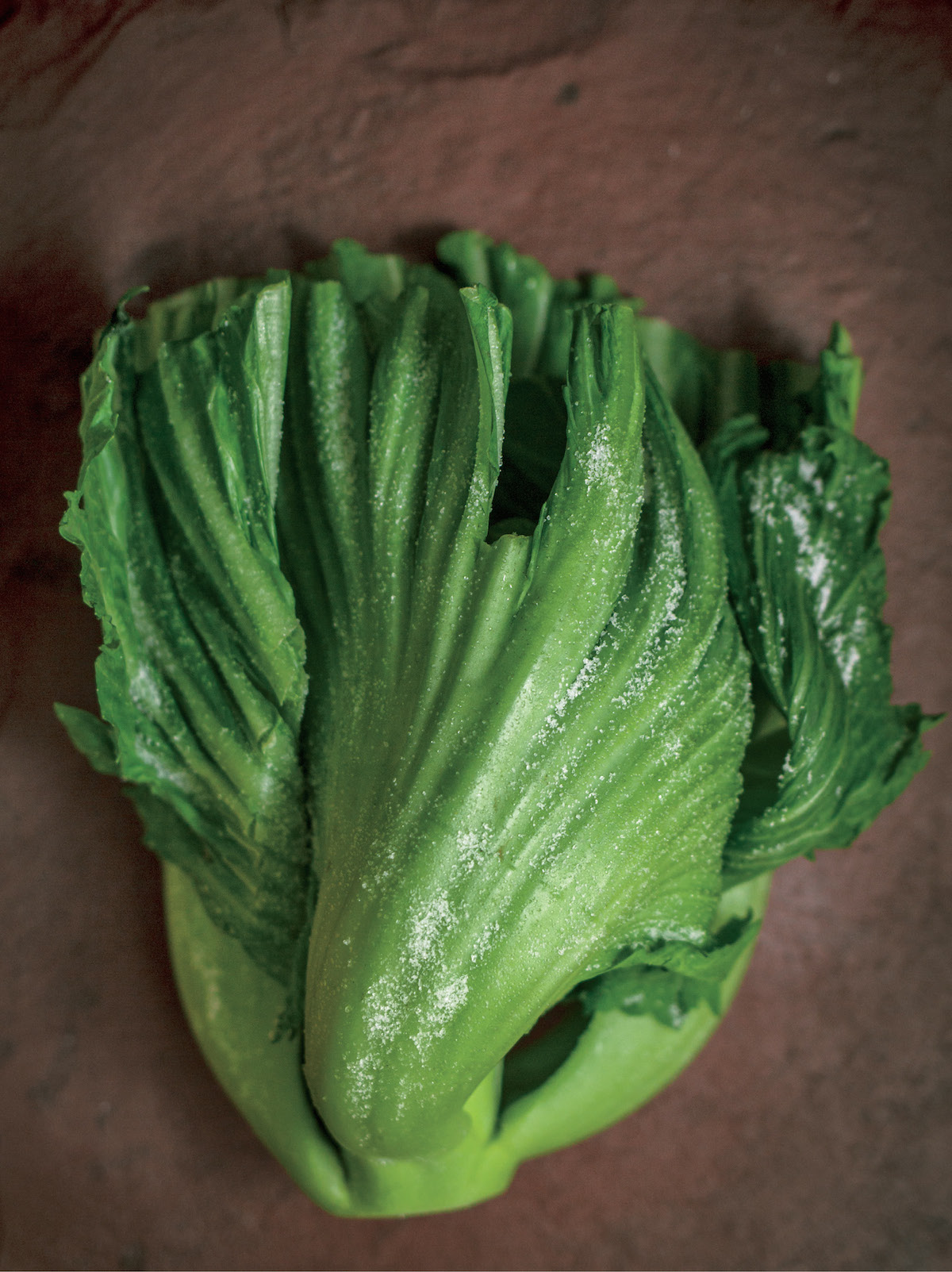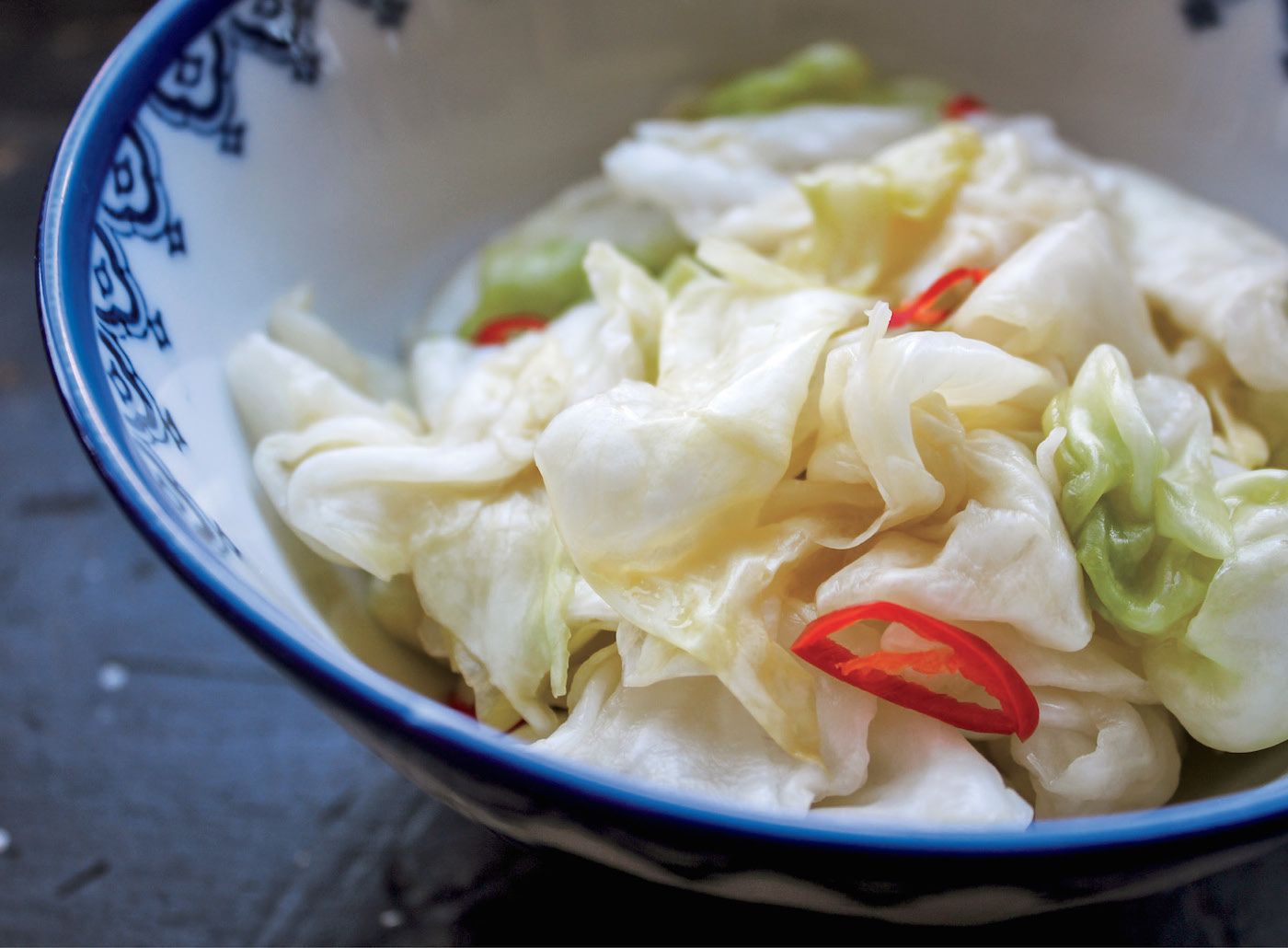Fried Shallots (Hong Cong Tou)
紅蔥頭
Makes about ½ cup
Crispy, golden fried shallots are a common garnish in Taiwan. Whether floating across soups or sprinkled atop rice bowls, they lend a sweet, crunchy depth to dishes. In Taiwan, one can purchase a canister of them to keep in the pantry. But if you don’t mind a quick fry session at home, you can easily make a fresh batch yourself.
- 6 medium shallots
- ½ cup vegetable or peanut oil, or more as needed, for frying
Slice the shallots as thinly and as uniformly as possible (with the help of a mandolin if desired).
Add the oil to a small saucepan so that the oil is at least ½ inch deep (use more oil if necessary). Heat over medium-high until a candy thermometer inserted into the oil (but not touching the pan) reads between 350° to 375°F. Add the shallots all at once and begin stirring. Continue to cook, stirring, until most of the shallots have turned yellow-gold, about 2 minutes. Remove from the oil using a slotted spoon or tongs and transfer immediately to paper towels. Let cool for about 1 minute before using.
Use immediately or store in an airtight container for up to 1 day.
Sha-Cha Sauce (Sha Cha Jiang)
沙茶醬
Makes about 1 cup
This classic condiment in Taiwan is often labeled “barbecue sauce” in English. That’s because it shares the same root name as satay sauce in Southeast Asian cuisines. However, sha-cha sauce does not resemble the common, peanutty interpretations of satay sauce today: it’s a minced paste of dried fish and shrimp, shallots, garlic, and chilies. It actually shares more similarities with the Hong Kong “XO sauce” in its ingredient composition. The sauce is sometimes used as a marinade that is brushed on before food hits the grill—see the grilled corn recipe. However, it’s more commonly used in Taiwan to flavor stir-fries or soups, or to dip just-cooked ingredients from a hot pot. I have yet to meet a Taiwanese home cook who prepares this sauce rather than buying it in jars from a store. Yet the versions I’ve made are satisfying, and incorporate just a few rustic ingredients (without any additives like MSG). If you’re up for the experiment and have a food processor, try this recipe for your own homemade sha-cha sauce instead of simply purchasing a jar. I’ve even made close-enough versions using salt cod instead of the dried brill fish that is a main ingredient in bottled Taiwanese versions. You can make your sauce as spicy as you like by increasing the amount of dried chilies in the recipe below, or slightly sweeter with the addition of more sugar. Keep it covered in an airtight container in the refrigerator for up to three months for the best flavor.
- 1 head garlic, coarsely chopped
- 4 medium shallots, coarsely chopped
- 6 to 8 small dried red chilies (preferably seven stars chilies, or substitute with chiles de arbol), seeds removed and roughly crumbled (about 1 tablespoon)
- 1 ounce dried stock fish (found in Asian groceries) or dried salt cod, torn into small pieces
- 1 ounce dried baby shrimp
- ½ cup vegetable or peanut oil
- 1 tablespoon sugar
- ½ teaspoon salt
- 1 teaspoon light soy sauce
Place the garlic and shallots in a food processor and pulse for a few seconds. Scrape down the sides with a rubber spatula and add the chilies, dried fish, and dried shrimp. Pulse, stopping to scrape down the sides with a spatula, for 2 to 3 minutes until the mixture becomes fine, evenly-sized crumbs.
Heat the oil in a small pot over medium heat. Add the chili mixture and cook, stirring frequently, for about 10 minutes.
The mixture should resemble a golden, translucent sludge and the oil will have taken on a reddish-orange hue. Stir in the sugar and salt and continue cooking for another minute. Remove from the heat and stir in the soy sauce. Let cool completely before using.
Sweet-and-Sour Tomato–Based Sauce (Hai Shan Jiang)
海山醬
Makes about 1 cup
You won’t go a few days in Taiwan without encountering this thick, red-tinged sauce. It’s mild-tasting enough to liberally drench foods—like fried snacks—in a way that you couldn’t with more potently flavored sauces like soy sauce or ketchup. This sauce relies heavily on ketchup, a condiment associated with Western food trends.
- ¼ cup ketchup
- ¼ cup rice vinegar
- 1 tablespoon sugar
- 1 teaspoon soy sauce
- 1 teaspoon cornstarch
- ½ cup cold water
- Salt to taste
Add the ketchup, vinegar, sugar, and soy sauce to a small saucepan over medium-high heat and stir to combine thoroughly. Cook for a few seconds, stirring, until the sugar dissolves and the mixture is beginning to bubble. In a separate bowl, whisk together the cornstarch and water. Stir into the ketchup mixture and continue to cook, stirring, until thickened, about 1 minute. Add the salt to taste. Remove from the heat and let cool completely before serving.
Sweet-and-Sour Citrus and Soy–Based Sauce (Yang Sheng Zhan Jiang)
養生蘸醬
Makes about 1 cup
This sauce can be used interchangeably with Sweet-and-Sour Tomato–Based Sauce, such as for drizzling on tempura fishcakes. The use of fresh, tropical citrus juice is a given due to these fruits’availability on the island. The bright acidity of the resulting sauce makes it an excellent complement for savory, porky snacks like Meatball Mochi.
- ¼ cup fresh orange juice
- 1 tablespoon fresh lime juice
- 1 tablespoon rice vinegar
- 1 tablespoon sugar, plus more to taste
- 2 teaspoons soy sauce
- 1 teaspoon cornstarch
- ½ cup cold water
- Salt to taste
Add the orange juice, lime juice, vinegar, sugar, and soy sauce to a small saucepan over medium-high heat and stir to combine thoroughly. Cook, stirring, until the sugar dissolves and the mixture begins to boil. In a separate bowl, whisk together the cornstarch and water. Stir into the orange juice mixture and continue to cook, stirring, until thickened, about 1 minute. Add salt to taste. Taste for seasoning and add extra sugar or a pinch of salt as desired. Remove from the heat and let cool completely before serving.
Dumpling Dipping Sauce (Jiaozi Jiang)
餃子醬
Makes about ¼ cup
There is no such thing as the “best” or the “right way” to make a dipping sauce for dumplings, but this would be pretty on target. In reality, one can use soy sauce, vinegar (preferably aged or black vinegar, for its sweeter, mellower taste), thick soy sauce, their favorite chili sauce, or any combination of those to dip dumplings. But I prefer a fifty-fifty ratio of soy sauce and vinegar, which works well even if you only have sharper-tasting clear rice vinegar instead of aged. A dab of sesame oil adds savory depth and a flourish of ginger matchsticks on top can’t hurt, either.
- 2 tablespoons light soy sauce
- 2 tablespoons rice vinegar
- ½ teaspoon sesame oil
- 1 teaspoon peeled and very thinly julienned fresh ginger (preferably young ginger, if you can find it)
Combine the soy sauce, vinegar, and oil in a sauce dish and scatter the ginger on top.
Pickled Mustard Greens (Zha Cai)
榨菜
Makes 2 quarts
There are numerous types of vegetables that are pickled until piquant and pucker-worthy in Taiwan. Chopped and tossed into noodle soup, congee, or scrambled with eggs, these salty bites are a convenient way to add flavor to rustic dishes. Chinese mustard greens, with their large, fibrous ribs and stems, are commonly pickled in a traditional lacto-fermented procedure (similar to making kimchi and sauerkraut). Most home cooks don’t pickle their own mustard greens nowadays, as they’re readily found premade in jars in Taiwan. But with about seven days’ time and a lot of salt, a homemade version is simple.
- 1 head Chinese mustard greens, trimmed of any wilted leaves and tough stem at the base
- ¼ cup plus 2 tablespoons kosher salt or sea salt
- 4 cups water
In a large bowl or on a large plate, sprinkle the mustard greens evenly with 2 tablespoons of the salt. Let sit for 1 hour at room temperature. Rinse briefly under cold water and squeeze the mustard greens well to remove excess liquid.
In a large bowl, stir the remaining ¼ cup salt into the water until the salt is completely dissolved. Sterilize a 2-quart glass jar by completely submerging it in boiling water for 10 minutes. Remove carefully with tongs and drain. Stuff the mustard greens inside the jar (slicing them in half if necessary to fit). Pour the saltwater solution all the way to the top of the jar, making sure to submerge the greens. Cover with a lid. Keep away from light at room temperature until sufficiently tangy and briny tasting, 7 to 8 days (this may take as few as 5 days in the warm summer months, or up to 10 days in colder temperatures). You may open and close the jar to check on the progress in the meantime; the jar will open with an audible releasing of gases once it’s fermented, and you may allow it to ferment longer for a stronger flavor. In general, I recommend 7 days of fermenting at room temperature. Afterward, store, airtight, in the refrigerator.
Pickled Mustard Greens Relish (Xue Cai)
雪菜
Makes ¼ cup
This simple relish incorporates the completed pickled mustard greens, seasoned with sesame oil and chili flakes for enhanced flavor.
- ¼ cup shredded Pickled Mustard Greens
- 2 teaspoons sesame oil
- 1 teaspoon light soy sauce
- ¼ teaspoon dried red chili flakes (optional)
Combine the mustard greens, sesame oil, soy sauce, and chili flakes, if using, in a small bowl and stir well. For the best flavor, store in an airtight container in the refrigerator for up to 3 months.
Vinegar-Pickled Cabbage (Suan Cai)
酸菜
Makes about 2 cups
Crunchy and tangy, these overnight pickles are often served as a cold appetizer or side dish. Their bright acidity makes for a great pairing with greasy or very strong-tasting foods, like fried wedges of Taiwanese stinky tofu.
- 1 pound green cabbage, coarsely shredded or torn into pieces no wider than 2 inches (yielding about 4 cups)
- 1 tablespoon kosher salt or sea salt
- ½ cup rice vinegar
- ¼ cup sugar
- 1 tablespoon peeled and julienned fresh ginger
- 1 to 2 small fresh red chilies, thinly sliced
In a large bowl, toss the cabbage with the salt. Let sit for 1 hour at room temperature. Rinse under cold water and squeeze well to remove excess liquid.
Heat the vinegar and sugar in a small saucepan over medium heat, stirring, just until the sugar is dissolved completely. Let cool completely to room temperature.
In a large bowl, toss the cabbage with the ginger, chilies, and vinegar solution. Mix well to distribute the liquid evenly and press into an airtight container. Refrigerate at least 10 hours before serving (preferably giving the cabbage a stir one or two times in between). For the best flavor, store, covered, in the refrigerator for up to 3 days.
Sweet Soy-Pickled Cucumbers (Yan Xiao Huang Gua)
醃小黃瓜
Makes about 2 cups
These pickles are stained deep brown from soy sauce and have a very sweet flavor, almost akin to gherkins. They’re far more likely to be purchased rather than made at home, but they can be prepared using a simple method and classic Chinese ingredients. For best results, look for Asian cucumber varieties with crisp, nearly seedless interiors.
- 1 pound small pickling cucumbers, such as Persian cucumbers
- 2 teaspoons kosher salt or sea salt
- ½ cup rice vinegar
- ¼ cup dark soy sauce
- ¼ cup water
- ¼ cup sugar
- 1 star anise
Trim the ends from the cucumbers and chop into ½-inch pieces. In a large bowl, toss the cucumbers with the salt to coat thoroughly. Let sit for 30 minutes to 1 hour at room temperature. Rinse briefly under cold water. Drain and squeeze well to remove excess liquid.
Combine the vinegar, soy sauce, water, sugar, and star anise in a small saucepan over medium-high heat and bring just to a boil, stirring to thoroughly dissolve the sugar. Let cool completely to room temperature (or refrigerate, covered, overnight). Discard the star anise. Pour the mixture over the cucumbers in a large bowl or airtight container. Cover and refrigerate at least 24 hours before serving. Store, covered, in the refrigerator for up to 1 week.
Spicy Marinated Cucumbers (Suan La Xiao Huang Gua)
酸辣小黃瓜
Makes about 1 quart
There are endless ways to make a cold appetizer of marinated cucumbers in Taiwan, but any way you season them, they’re a common sight at multicourse meals. I enjoy them with a fierce kick of garlic and chili sauce, and only a touch of sugar and acidity.
- 2 pounds cucumbers, peeled, seeded, and chopped
- 1 tablespoon kosher salt or sea salt
- 2 tablespoons rice vinegar
- 1 tablespoon sugar
- 4 garlic cloves, finely chopped
- 1 teaspoon sesame oil
- 1 tablespoon chili bean sauce
In a large bowl, sprinkle the cucumbers with the salt and toss to coat evenly. Let sit for 30 minutes to 1 hour at room temperature. Rinse briefly under cold water. Drain and squeeze well to remove excess liquid.
In a large bowl, stir together the vinegar, sugar, garlic, oil, and chili bean sauce, then fold in the cucumbers and toss to coat. Cover and refrigerate for at least 6 hours, or preferably 12 hours, before serving. For the best flavor, store, covered, in the refrigerator up to 2 days.
Crushed Peanut Powder (Hua Sheng Fen)
花生粉
Makes about ½ cup
Whether a topping for iced desserts, sautéed vegetables with garlic, bowls of noodles, or steamed buns, crushed peanuts are widely used in Taiwanese cuisine. This condiment is shared—along with fried shallots—with Taiwan’s neighboring Southeast Asian cuisines. However, in Taiwan, the peanuts are usually found ground more finely, and are blended with sugar to create a powdery consistency. Be careful not to overmix the peanuts while using a blender or food processor, or else these loose crumbs will begin to bind into a pastelike consistency.
- 1 cup roasted unsalted shelled peanuts, skins removed
- 2 tablespoons sugar
Place the peanuts and sugar in a food processor or blender. Pulse until the mixture resembles coarse crumbs with some finer, powdery dust, about 1 minute, stopping to scrape down the sides intermittently. Store at room temperature, covered, for up to 1 week.




